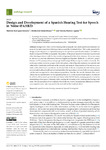Mostrar o rexistro simple do ítem
Design and Development of a Spanish Hearing Test for Speech in Noise (PAHRE)
| dc.contributor.author | Rodríguez-Ferreiro, Marlene | |
| dc.contributor.author | Durán-Bouza, Montserrat | |
| dc.contributor.author | Marrero-Aguiar, Victoria | |
| dc.date.accessioned | 2023-04-12T11:44:10Z | |
| dc.date.available | 2023-04-12T11:44:10Z | |
| dc.date.issued | 2022-12-30 | |
| dc.identifier.citation | Rodríguez-Ferreiro, M.; Durán-Bouza, M.; Marrero-Aguiar, V. Design and Development of a Spanish Hearing Test for Speech in Noise (PAHRE). Audiol. Res. 2023, 13, 32–48. https://doi.org/10.3390/ audiolres13010004 | es_ES |
| dc.identifier.issn | 2039-4349 | |
| dc.identifier.uri | http://hdl.handle.net/2183/32869 | |
| dc.description.abstract | [Abstract] Background: There are few hearing tests in Spanish that assess speech discrimination in noise in the adult population that take into account the Lombard effect. This study presents the design and development of a Spanish hearing test for speech in noise (Prueba Auditiva de Habla en Ruido en Español (PAHRE) in Spanish). The pattern of the Quick Speech in Noise test was followed when drafting sentences with five key words each grouped in lists of six sentences. It was necessary to take into account the differences between English and Spanish. Methods: A total of 61 people (24 men and 37 women) with an average age of 46.9 (range 18–84 years) participated in the study. The work was carried out in two phases. In the first phase, a list of Spanish sentences was drafted and subjected to a familiarity test based on the semantic and syntactic characteristics of the sentences; as a result, a list of sentences was selected for the final test. In the second phase, the selected sentences were recorded with and without the Lombard effect, the equivalence between both lists was analysed, and the test was applied to a first reference population. Results: The results obtained allow us to affirm that it is representative of the Spanish spoken in its variety in peninsular Spain. Conclusions: In addition, these results point to the usefulness of the PAHRE test in assessing speech in noise by maintaining a fixed speech intensity while varying the intensity of the multi-speaker background noise. The incorporation of the Lombard effect in the test shows discrimination differences with the same signal-to-noise ratio compared to the test without the Lombard effect. | es_ES |
| dc.language.iso | eng | es_ES |
| dc.publisher | MDPI | es_ES |
| dc.relation.uri | https://doi.org/10.3390/audiolres13010004 | es_ES |
| dc.rights | Atribución 3.0 España | es_ES |
| dc.rights.uri | http://creativecommons.org/licenses/by/3.0/es/ | * |
| dc.subject | Speech in noise | es_ES |
| dc.subject | Hearing assessment | es_ES |
| dc.subject | Spanish hearing test | es_ES |
| dc.title | Design and Development of a Spanish Hearing Test for Speech in Noise (PAHRE) | es_ES |
| dc.type | info:eu-repo/semantics/article | es_ES |
| dc.rights.access | info:eu-repo/semantics/openAccess | es_ES |
| UDC.journalTitle | Audiology Research | es_ES |
| UDC.volume | 13 | es_ES |
| UDC.issue | 1 | es_ES |
| UDC.startPage | 32 | es_ES |
| UDC.endPage | 48 | es_ES |
Ficheiros no ítem
Este ítem aparece na(s) seguinte(s) colección(s)
-
GI-GIPDAE - Artigos [16]






